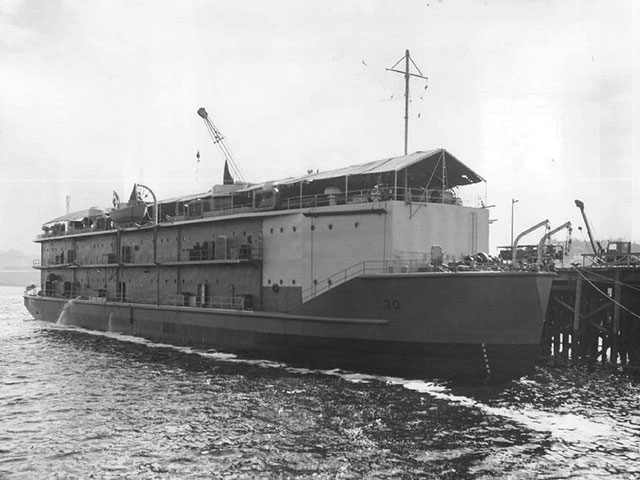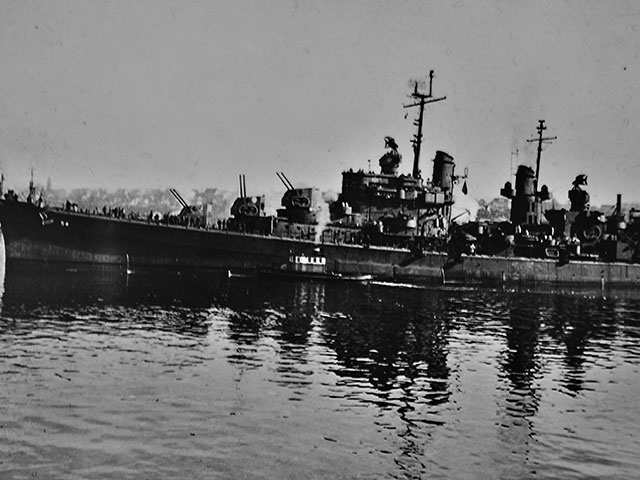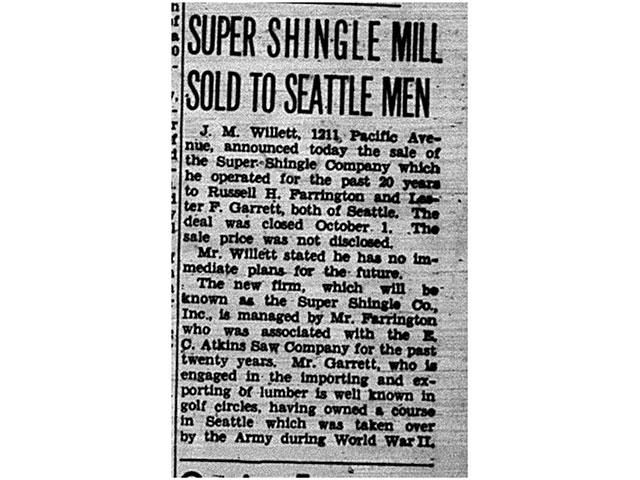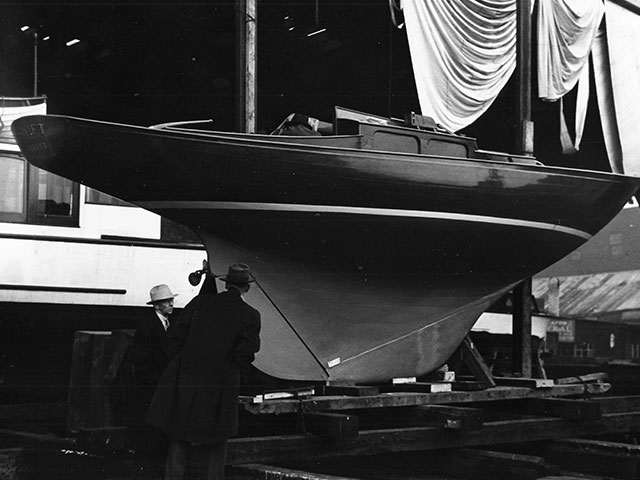1940 - 1949
Timeline
1941
Japan bombs the American fleet in Pearl Harbor, Hawaii, on December 7, prompting the United States to join World War II.
1942
With the onset of World War II, Tract O at the foot of 21st Street on Norton Avenue (now West Marine View Drive) is taken over by the federal government via the War Powers Act, and the huge Everett Pacific Shipbuilding and Dry Dock Company plant is built there. This prompts a move of the commercial fishing fleet to the 14th Street Dock. The Port had been awarded $233,500 for facilities taken over by the Navy, and new docks were created for the boats. A new net shed structure was built as well, serving as a workspace and storage area for the fishermen for decades to come. Pleasure boat moorage also eventually moves to this site.
1943 onward
The Port discusses postwar projects, including closing the gap between Preston Point and the north end of the jetty to stop further silting in Everett harbor and to alleviate ongoing problems with storing logs in salt water. The plan is eventually scrapped; powerful Snohomish River currents make the project unfeasible.
1944
The Bozeman Canning Company is the first fish processing plant to open on the Port’s north bayfront, east of the new commercial fishing net sheds “on the new Fourteenth Street Port fill.” The company is later called the Pictsweet Canning Company (1946), then the Everett Fish Company.
1945
With the Japanese surrender on September 2, World War II ends.
1946-47
Fishermen’s Boat Shop (renamed Everett Shipyard in the 1980s), an important support facility to commercial fishing and initially located at the foot of Bond Street on the Port’s south bayfront, relocates to the north bayfront near the foot of 14th Street.
1947
The City of Mukilteo is incorporated.
1948
The Morris brothers bring their boat-building skills from Bellingham, Washington, to the Port’s bayfront. The brothers — J. Paul and Walter “Walt” Morris — are soon to become key figures in the industry. They begin building small, wooden speedboats under the Morris name on the 14th Street Dock, where Scholl’s Marina had previously operated. The Morris’ all-plywood pleasure crafts — the first being 12- to 16-foot “Runabouts” — were by all accounts high-quality boats. The brothers would also design a 32-foot Bristol Bay gillnetter for the fishing industry; the vessels had wooden hulls and red cedar planking. (At least one of these, the Robbie, was still being used by an Everett fisherman in 2010.)
1948
By this date, several barges had been sunk along the north bank of the mouth of the Snohomish River for a breakwater. This was a common method of disposing old boats at the time; some are still there today, off the north end of Jetty Island.
1948
The Everett Sail and Power Squadron group of boating education volunteers is formed in an effort to teach the influx of post-war pleasure boaters how to be better and safer boaters. Programs over the decades include vessel safety checks, staffed information booths, life jacket stations, and marina cleanup days. The group still serves the Port of Everett today.
1949
The Port sells its Ebey Island airport property on Highway 529 between Everett and Marysville for $10,000 to Marysville resident Robert Pautz.
1949
Although many hoped the huge Everett Pacific Shipbuilding and Dry Dock Company plant would shift from wartime production to peacetime ship repair, by the end of the decade the yard was closed. The site was later used by Western Gear, a heavy machinery manufacturer. Today the area is part of Naval Station Everett.
Pitching in During World War II
As with nearly every other corner of the globe, World War II permeated activity at the harbor this decade, starting in 1942 when the federal government saw the inherent value in Everett’s location and deep-water port — and used the War Powers Act to take over the 62-acre Tract O, the relatively new home of the commercial fishing fleet, to build the Everett Pacific Shipbuilding and Dry Dock Company.
The shipworks, located at the foot of 21st Street along Norton Avenue, employed more than 6,000 men and women who built ships, barges, harbor tugs and mobile dry docks for the U.S. Navy. The operation ran there from 1942 to 1949 and started out with a bang, launching 49 watercraft in its first 36 months alone.
The federal government provided some funds as restitution for the takeover of the property, however, and the Port used the money to relocate the commercial fishing fleet again — this time to the 14th Street Dock — as well as to build new sheds there for the fishermen to dry and repair their nets. At the same time, the Port began filling the area underneath and around the dock. The Port filled the area north from 14th Street to about 12th Street, leaving the old dock as the southern boundary of the earthen fill. After the war ended in 1945, the Port added more earthen fill to this area, a project that would continue over the next several decades.
Pleasure boat moorage was also on the move, shifting from its home in the shipping terminal area between Piers 1 and 2 to the 14th Street Dock small boat basin (now called Central Docks). With both fleets’ relocations, the 1940s brought to an end the major industrial focus in the Port’s north bayfront area, ushering it into a period that focused heavily on fishing and leisure use. Fishermen’s Boat Shop, an
important support facility to commercial fishing, relocated there, and fish canneries such as the Bozeman Canning Company were eager to set up shop in the area as well.
The war created a market for wood products, but the mills experienced a labor shortage as the militaryt ook much of the potential workforce. Besides it being a homeland security necessity to staff the Naval shipyard, workers could earn more there, as well as at a bomber plant that The Boeing Company had built in Seattle to the south. This situation finally prompted the federal government to “freeze” people in their jobs so they couldn’t leave the mills — to take higher-paying shipyard jobs, for example. The labor shortage also brought women into the work force in numbers never before seen.
Throughout the decade, the Port kept pushing forward. It received ongoing requests for additional boat moorage and sites for lease — for marinas, boat service stations, canneries and similar uses, and it didn’t want to lose that business. In addition to creating land through earthen fills, the Port Commission informed the city that it was interested “in any tax title tidelands that might be disposed of” and asked that it be notified “anytime any sales were contemplated.” Near the end of the war, the Port focused on trying to regain properties that had been taken over by the military, such as the Mukilteo ferry terminal and the shipyard area at Tract O. But the Navy would control that land, which included the old fishing boat moorage and net sheds, until January 1959.
The Port also continued to pursue the idea of closing the gap between Preston Point and the north end of the jetty “as a postwar project” — a project many had been wanting to do since the 1920s. The goal was to stop further silting of the harbor, as well as to create a freshwater storage site for logs. The Port made progress in 1944 by reaching an agreement with mill owners in the north end of the harbor for the eventual closure of the river channel there, but the plan remained in flux through the end of the decade. The project eventually was abandoned; the strong Snohomish River currents made the harbor too difficult to enclose.
In the late 1940s, a proposal to start development of the jetty as a site for industries and deep-water terminals was considered by the Port Commission. The jetty’s 2,000 acres comprised the last large undeveloped tract in Puget Sound and could potentially be the key to future industrial development in Everett, as well as the in entire Puget Sound region. However, no action was taken on the proposal.
















